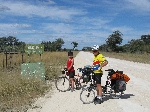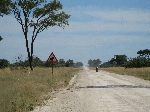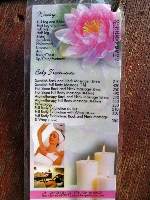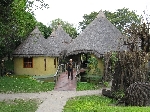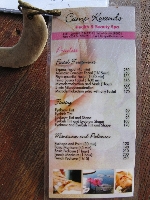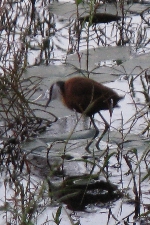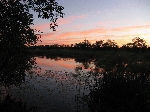Botswana / Namibia:
|
||
Dispatch 6 - Kongola |
||
|
As you approach Kongola you enter into an area with a greater concentration of western-style tourist facilities and western tourists. An early indication were "traditional villages" that catered to tourists. To see if we were missing anything we visited one. Contrary to missing anything we had seen much more of the real Caprivi in the places we had been visiting. The "traditional village" was notably empty and sterile.
If you sat at the bar the conversation was likely to be with South Africans and maybe about wildlife but more likely about the exploits of catching the aggressive and fierce tigerfish (Hydrocynus vittatus). A prized game fish and one of the primary draws for the South Africans who frequent the lodge. Away from the bar, when they became available, the bicyclists dug into the bowls of happy-hour- peanuts like you might expect them to do after a ride -- it had been a long time since lunch and dinner was later than we were used to. All-in-all, it was a relatively short day on the bikes and we had a nice and relaxing afternoon and evening. Not shown is all of the groups freshly washed laundry hanging off the railings of our tented cabins -- perhaps it wasn't accidental that they put us at the far end of the facilities. As you might expect there is a new-to-this-excursion ethnic group in the area around Kongola, the Mbukushu, speaking Timbukushu. It is another ethnic group with roots in Angola and Zambia. It is believed that the initial Mbukushu in this area originally lived further to the east, along the Zambezi river, near Katima Mulilo. In the 1750's, due to the expansionist behavior of Lozi Chief Ngombala, they moved west to the Kwando River. The Makololo conquered the whole of this region in about 1838 and controlled it until 1864 when they were defeated by the Lozi in an ambush by the army of Lozi King Sipopa. The Lozi then became rulers. In 1865, the Lozi appointed a headman or induna, Kabende Simata over the Mayeyi, Mafwe, Mbukushu and Matotela. Lozi King Sipopa was succeeded by Lewanika, who reigned from 1884 to 1916. In the 1980s, because of the Angolan civil war, there was a new influx of Mbukushu from the north. The Mbukushu now cover an extended area of Namibia and Botswana; along the Caprivi Strip west of Kongola to Duvundu and south from Duvundu into Botswana to Shakawe, Sepopa and the Etsha's. The morning greeting is "mwapinduka." The afternoon greeting is "mwaghondho." And, thank you is "tumara." If you learn these greetings you will actually be able to practice and utilize them for a few days ahead. |
Addendum: Bayei
and Mbukushiu Culture: |
|
| . | ||
|
||
|
Unique Programs To Special Places For Memories Of A Lifetime!
"Hosted by
DreamHost - earth friendly web hosting"
|
||
|
|
|
